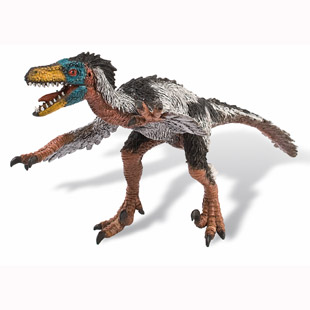New Feathered Velociraptor model from Bullyland of Germany
Today, we sing the praises of the feathered Velociraptor dinosaur model from Bullyland.
It has been widely accepted for almost 40 years that birds are descended from a group of dinosaurs – the theropods. Although similarities between the skeletons of modern birds and the fossils of certain small, bipedal dinosaurs had been pointed out as long ago as the 19th century with scientists such as Thomas Huxley commenting on their similar anatomies, it was the ground breaking work of the American palaeontologist John Ostrom on the dinosaur that was to become known as Deinonychus that paved the way.
Agile, Speedy Hunters
John Ostrom’s work was published in 1969 and he depicted Deinonychus, a man-sized dromaeosaur from North America as an active, agile, speedy hunter. Since then the scientific view of dinosaurs has been dramatically changed. Gone are the perceptions of lumbering giants to stupid to survive, instead we now see dinosaurs as a highly successful and adaptable group with a wide range of adaptations to help them survive in a wide variety of environments.
Thanks to the amazing fossils that have been excavated from the Liaoning Province in the Sihetun region of north-eastern China scientists have an opportunity to study a whole array of small, feathered theropods. Over the last twenty years or so, an amazing number of fossils have been discovered in this area. It seems that around 125 million years ago, in the Early Cretaceous this part of China was covered in lush forests and large lakes in a volcanically active area. Occasional eruptions covered the area in fine volcanic ash and dust, rapidly entombing many of the inhabitants of the area.
Feathered Dinosaurs
Many other creatures of the forest were suffocated by gas escaping from the volcanic fissures. The fine volcanic dust has helped preserve some remarkable details of those animals and plants unfortunate to succumb to the volcanic activity. The dust and ash sealed out oxygen preventing decay and the fine grained structures of these materials has permitted the preservation of details of hair and feathers.
Hence the preservation of a number of feathered dinosaurs, the first of which Sinosauropteryx was discovered in 1995. Here was fossil evidence to back up what many scientists had speculated about for some time – that many small dinosaurs were covered in feathers. It has been suggested that simply proto-feathers evolved to help keep these small active animals warm, a form of insulation.
Later plumes and crests may have evolved for display purposes. Many of these feathered dinosaurs were classed as members of the Maniraptora, a group that also includes the dromaeosaurs like Deinonychus and Velociraptor. If this type of dinosaur had feathers, why not the likes of Deinonychus and Velociraptor?
Although, there is very little fossil evidence to back up this theory, it is now widely believed that little dromaeosaurs like Velociraptor were feathered too. The covering of feathers would help to keep these little animals insulated, a necessity given their active, warm-blooded lifestyles.
Feathered Velociraptor Dinosaur Model
Building on the scientific speculation, Bullyland of Germany have introduced a feathered Velociraptor model, depicting how this 1 metre high dinosaur might have looked. This model is a new addition to the Bullyland prehistoric animal models range.
To view the Bullyland range of dinosaur and prehistoric animal figures available from Everything Dinosaur: Bullyland Prehistoric Animal Models and Figures.
The New Velociraptor Model

Picture credit: Bullyland
To view this model of Velociraptor and other prehistoric animal figures: Dinosaur and Prehistoric Animal Models.
This model is depicted in 1:20 scale and shows the latest scientific interpretation of this fierce little dinosaur, whose fossils have been found in Mongolia, China and Russia. It is suspected that like most other dinosaurs, Velociraptors had good colour vision, so the blue face band and the black feathered head crest have been added in deference to the theory that feathers and colours may have been used for display, especially as these animals are thought to have lived in packs.






Velociraptors are almost 2m high, I thought…
Films like the Jurassic Park series exaggerated the size of Velociraptors. The dinosaur Velociraptor (V. mongoliensis) was nowhere near as big as depicted in the film Jurassic Park. Ironically, an American dinosaur – Deinonychus was about the size of the Velociraptors seen in the film. Why Deinonychus was not chosen is a bit of a mystery.
Actually, in the novel Jurassic Park by Michael Creighton, on which the film is based, the raptors in the book were indeed Deinonychus, as Deinonychus was also called Velociraptor at the time (being two genera). So he was correct in calling them Velociraptor. It is actually alluded to in the film, the opening sequence is set in the USA and they are excavating a 'Velociraptor' fossil. Velociraptor mongoliensis (now called V. osmolskae) never lived in North America, but Deinonychus did.